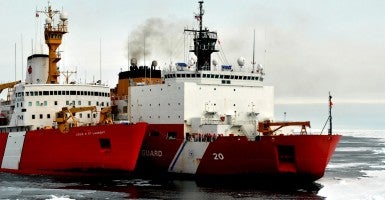President Obama’s visit to Alaska last month brought deserved attention to the American Arctic.
While the president spent most of his trip discussing climate change, both he and Congress should focus more on real challenges in the region such as energy resources, safety and security concerns, and Russia’s aggressive posturing in the Arctic.
One way the government can enhance its presence in the region is through a more adequate icebreaker fleet. The Coast Guard has stated a need for three heavy and three medium polar icebreakers, yet it currently only sails two.
Meanwhile Russia sails a fleet of 19 icebreakers including six nuclear-powered heavy polar icebreakers that are among the most capable in the world.
Putin is looking longer term at Russia’s Arctic energy resources. Russian firm Novatek, is partnering with China’s CNPC and France’s Total to develop the Yamal natural gas field and a global shipping consortium is working to build 16 LNG tankers with icebreaking capabilities in order to transport this resource from Yamal to areas such as Southeast Asia.
In addition to future energy resources, U.S. Arctic waters have the potential to provide new fisheries and sea lanes that will enhance the economy locally and nationally. In spite of increased access to such resources, the U.S. continues to lag behind in pursuing and protecting its strategic and economic interests in the Arctic. Increasing our icebreaking capabilities would allow the U.S. to assert itself as a true power in the Arctic.
Congressional Research Service maritime expert Ronald O’Rourke explains,
“[D]iminishment of polar ice could lead… to increased commercial ship, cruise ship, and naval surface ship operations, as well as increased exploration for oil and other resources- activities that could require increased levels of support from polar icebreakers.”
The Obama administration acknowledged this shortfall and stated its intent to “develop and maintain capacity for year-round access to greater expanses within polar regions,” and that it seeks to “accelerate acquisition of a replacement heavy icebreaker to 2020 from 2022.”
This statement fails to mention that the Obama administration had previously delayed the icebreaker plan from its original 2018 procurement schedule. Essentially, the administration is playing fiscal year funny business, as it has moved the goalpost on polar icebreaker procurement once before by pushing this project from the fiscal year 2018 to 2022. The new “early” procurement date of fiscal year 2020 is later than the initially scheduled date of 2018.
One major roadblock is that a new heavy polar icebreaker could cost upwards of $1 billion.
Potential energy resources have driven much of the interest in America’s arctic waters in recent years. The Department of the Interior’s Bureau of Ocean Energy Management projects that “approximately 27 million barrels of oil and 131 trillion cubic feet of natural gas” are available off the Alaskan coast.
By extracting these resources, U.S. companies can continue to be a global leader on oil and gas production, generating jobs and economic opportunity in the process.
Royal Dutch Shell recently called off its Arctic drilling exploration in the Chukchi Sea off the coast of Alaska, partly due to low global oil prices, high energy extraction costs, and a strict regulatory environment. Though Shell has left open the possibility of returning to the Arctic in the future, the underwhelming findings in the Chukchi Sea have cooled interest in the near term.
In order to fulfill the increasing demand for icebreaking capability, Congress must consider other alternatives because it is unlikely that the Coast Guard will be able to afford them along with its other acquisition programs. One alternative is buying or leasing foreign-built icebreakers in order to provide the same capabilities at a lower cost. As economic interests in the Arctic continue to expand, it is imperative that the U.S. have an adequate icebreaking capability.































